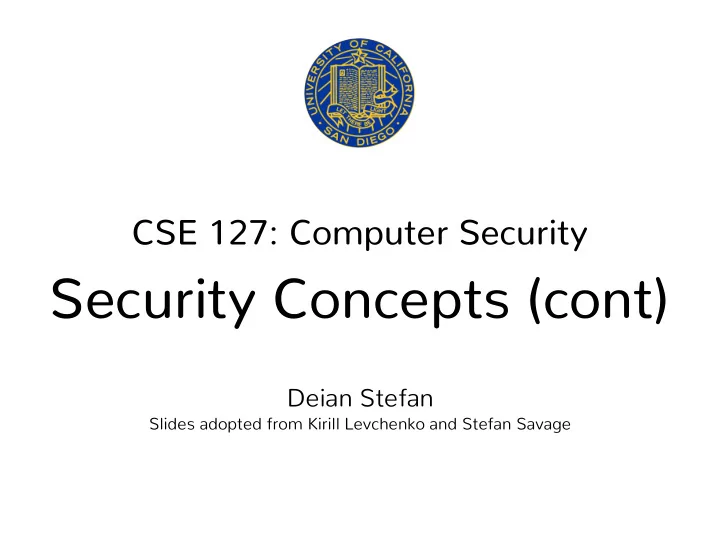

CSE 127: Computer Security Security Concepts (cont) Deian Stefan Slides adopted from Kirill Levchenko and Stefan Savage
Incentives and Deterrents • Attacker’s equation: (expected gain) > (cost of attack) • Defender’s equation: (cost of protection) < (expected loss)
Incentives and Deterrents • Attacker’s equation: (expected gain) > (cost of attack) + (expected punishment) • Defender’s equation: (cost of protection) < (expected loss)
Security Model • Subjects: Individuals or processes acting on their behalf • Objects: Protected information or function ➤ Objects often also include subjects • Subjects operate on objects ➤ System mediates and facilitates subject-object interaction
Security Policy • What action is subject allowed to do with object • Is this enough? ➤ And who can introduce new subjects and objects into system?
Security Policy • What action is subject allowed to do with object • Is this enough? ➤ And who can introduce new subjects and objects into system?
Access Control Matrix Objects {allowed {actions} Subjects
Access Control Matrix Fruit from Tree Fruit from Tree Broccoli of Life of Knowledge Adam {see, eat} {see, eat} {see} Eve {see, eat} {see, eat} {see}
Access Control Lists (ACLs) • What are ACLs? ➤ • How are ACLs enforced? ➤ • Real world examples? ➤
Access Control Lists (ACLs) • An access control list of an object identifies which subjects can access the object and what they are allowed to do • ACLs are object-centric: access control is associated with objects in the system • Each access to object is checked against object’s ACL • Example: guest list at a night club
Capabilities • What is a capability? ➤ • How are capabilities enforced? ➤ • Real world example of capabilities?
Capabilities • A capability grants a subject permission to perform a certain action ➤ Unforgeable ➤ Usually transferrable • Capabilities are subject-centric: access control is associated with subjects in the system • Example: car key
Unix File System Security Model • Subjects: • Objects: • Actions:
Unix File System Sec. Model • Subjects: Users • Objects: Files and directories • Actions: read, write, execute ➤ Execute a file means can call exec() on file ➤ Directory “execute” means user can traverse it • Unix is a simplified ACL system ➤ Arbitrary ACLs not possible in traditional Unix ➤ Modern Unix operating systems allow arbitrary
Permissions • Each file has an owner and a group ➤ Group: named set of users • File permissions specify what owner, group, and other (neither owner nor group) is allowed (read, write, exec) -rwxrw-r--
Permissions • Each file has an owner and a group ➤ Group: named set of users • File permissions specify what owner, group, and other (neither owner nor group) is allowed (read, write, exec) -rwxrw-r-- Other’s permissions Group’s permissions Owner’s permissions
Permissions • User’s allowed actions on file are: ➤ Owner’s permissions if the user is the owner, ➤ Group’s permissions if the user is in the group, ➤ Other’s permissions otherwise
Permissions • Users interact with system via processes acting on their behalf • When you interact with system via terminal, command shell acts on your behalf • Each process is associated with a user
Permissions • Who can change permissions? ➤ Only owner and superuser can change permissions • Who can change owner? ➤ Only superuser can change owner • Who can change group? ➤ Owner can only change to group she belongs to
Permissions • Can you change group to arbitrary group? ➤ A: yes, B: no
Permissions • Only owner and superuser can change permissions • Only superuser can change owner • Only owner and superuser can change group ➤ Owner can only change to group she belongs to • User’s allowed actions on file are: ➤ Owner’s permissions if the user is the owner, ➤ Group’s permissions if the user is in the group,
Login • When user connects to system via physical terminal, system runs login process as root to start session ➤ Authenticates user using username and password ➤ Changes its user id and group id to that of user ➤ Executes user’s shell • sshd performs similar actions
Login • When user connects to system via physical terminal, system runs login process as root to start session ➤ Authenticates user using username and password ➤ Changes its user id and group id to that of user ➤ Executes user’s shell • sshd performs similar actions
Changing Privilege • Superuser can drop privilege to become regular user
Changing Privilege • Superuser can drop privilege to become regular user • Want way to elevate privilege in controlled manner
Changing Privilege • Superuser can drop privilege to become regular user • Want way to elevate privilege in controlled manner • How?
Elevating Privilege • Executable files have a setuid and setgid bit • If setuid is set, files is executed with privilege of owner ➤ ruid is that of executing user, euid and suid that of owner • The setgid bit does same for group ➤ But supplementary groups remain that of executing user
Unix Security Model • What do you like about the Unix security model? • What do you dislike about it? • Is it a good model?
Recommend
More recommend